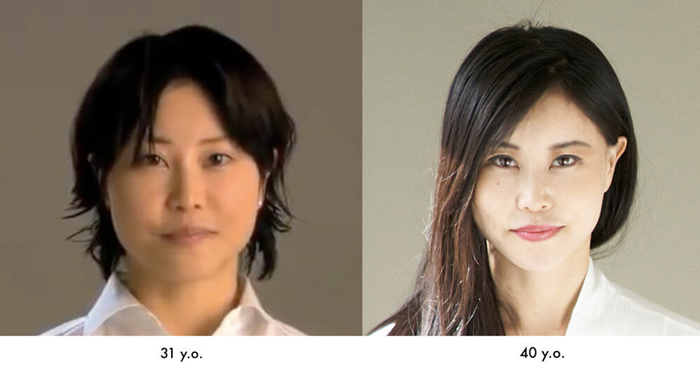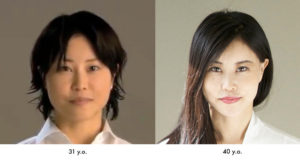Meet Koko Hayashi—a 41-year-old face yoga instructor who hasn’t aged a day since she turned 27. In case you’re wondering, face yoga constitutes a series of facial exercises that stimulate the muscles, tighten the skin and subsequently reduce the signs of ageing.
Face yoga is nothing new, but the practice has recently become a global phenomenon. In fact, you may have seen it in action on a very entertaining episode of Keeping Up With The Kardashians—that’s right, Hayashi’s clientele includes none other than the Kardashian Klan.
Ahead, let Hayashi impart her Kardashian-approved anti-aging wisdom onto you (and glean some easy face yoga exercises to try out in the process).
Lesson #1: Watch your face posture
Your first question is probably “What the heck is face posture?”. Fret not—the answer is simple. As Hayashi puts it: “It’s when your face isn’t doing anything—your resting face. When we work on face posture, I’m teaching you how to move your facial muscles properly for all the daily facial activities like resting your face, eating, drinking, speaking and even smiling.”
“If your natural face posture is ‘bad’, or you’re prone to bad facial expression habits, you’re likely to experience signs of premature ageing. In America, they call it ‘resting b*tch face’, though that’s not very nice. I was gonna say that on TV but they told me not to (laughs).”
Hayashi particularly loves to define ‘bad face posture’ as ‘Donald Trump face’—specifically, face posture that ‘drags your face muscles down’. Still confused? Here’s a nifty video to walk you through!
Mini Crash Course: Tongue Posture 101
It may sound weird, but tongue posture is a hot topic in Hollywood! It basically refers to where your tongue falls in your mouth. Hayashi says the ideal placement for your tongue is flush against the upper palate of your mouth because “if it’s on the bottom, then it’s going to sag your face downwards. All the tension in your face is going to be going downwards, pulling the overworking facial muscles down. It will give you jowls, nasolabial lines, cheekbone meltdown—it’s not good.
“Ideally, you want to suck your tongue up flat against the roof of your mouth for the majority of the day. Trust me—it keeps you young! By doing so you are going to lift up your heavy skull and train your muscles.”
Lesson #2: Work your face muscles
Here are the muscles in your face. According to Hayashi, there are two kinds: the overworked muscles (in red) and the sleeping muscles (in blue).
“The sleeping muscles drop with age if you don’t train them (thanks to gravity), so you need to wake them up to lift up the skin and prevent drooping. The overworked muscles which cause sagging and wrinkles, so you need to relax them.”
However, working out your face muscles will do little good if you’re not adopting the right face posture to back it up. “Even if you do good exercises, having bad face posture and pulling bad facial expressions is going to undo your hard work and you’re not going to see results,” says Hayashi.
A few 10-second face exercises a day coupled with good face posture is enough to stop the clock (at least for a little while longer). You only really have to do around three or four a day, which is only about 3-5 minutes of your time in total.
So, what exactly do these face exercises entail? Well, here are the ones we covered in our 60-minute session:
Warm-up
The warm up is simple—you’re just going to vibrate your cheeks by blowing air through your mouth. If that was unclear, you can watch the Kardashians do it:
View this post on Instagram
“When you perform any exercises, you need a warm-up. The cheeks are the core muscle of the face, just like how the abs are the core muscle for the body,” says Hayashi. “Vibrating your cheeks warms them up, and it’s also just a great way to relax the facial muscles. Every time you’re stressed or full of tension—or you’re about to meditate or go to bed—do this. It’s my favourite exercise to relax both my face and my mind.”
Warning: This is not an exercise for the office or the supermarket—we don’t want you spreading your fluids around. If, however, you’re at home by yourself (or in a closed space, alone), go for it!
Cheek squat
With this exercise, saggy cheeks and jowls are a thing of the past. As you age, the fat in your cheeks “melts down” which, according to Hayashi, leads to a few things.
1) Your cheeks will become sunken and hollow
2) You will get dog (not cat) eyes i.e. where the corners of your eyes begin to droop downwards
3) You may develop a nasolabial line
4) You may develop jowls
The solution? Do your cheek squats every day. Above is a cheek squat, for your reference. After a few reps of this, you’ll feel a burn in your cheeks, which is your sleeping muscles waking up and the lactic acid building up in your muscles.
Lower eyelid squat
Are your eyebags out of control? There’s an exercise for that too—lower eyelid squats. Hayashi explains the science behind the lower eyelid squat: “Around your eyeball is a layer of fat that is there to protect the eyeball. With age, the fat starts dropping, and eventually the top of your socket becomes hollow while the fat collects below to form an eyebag. Working out this area prevents this and improves its appearance.”
At this point, you may argue that there are actually surgeries that can get rid of the eye bag fat, and you are completely right. However, Hayashi explains that this isn’t the best option:
“There are surgeries to get rid of the fat, but it leaves you with a hollow eye socket that ages you. Once this happens, it’s difficult to fix—you can’t have filler in the hollow parts because it’s too close to your eyes. So, it’s better to do face yoga instead!”
Face symmetry exercise
There are many causes behind facial asymmetry, be it side sleeping, bad posture, and only working out one side of your face (aka when you chew on one side). However, the good news is that it can be fixed (or, at least, improved).
To sum up: You just want to squeeze your face over to one side as much as possible, and hold it there. If your face is relatively symmetrical, do both sides equally to keep everything even. If you happen to have a weaker side, or more asymmetry, you can work on the weaker side more to even out your face.
It’s also important to address the subconscious habits that may be contributing to your facial asymmetry. For example, if you’re prone to overusing one side of your mouth, try chewing on both sides of your mouth at the same time.
Lesson #3: Watch your subconscious habits
Want to avoid getting wrinkles? Follow these steps:
- Sleep on your back to prevent your pillow from rubbing and tugging on your sensitive facial skin as you sleep
- Don’t wrinkle and scrunch your nose when you laugh to prevent laugh lines. TIP: Keep your eyes slightly open when you laugh to prevent scrunching
- Don’t rub your eyes, rubbing will stretch your skin and lead to wrinkles
- Try to show as little of your lower teeth as possible when you talk as it prevents sagging and wrinkles
- Don’t wrap your lips or smack them—stretching your philtrum will cause it to age faster, making you look older
Lesson #4: Be patient with the results
Face yoga isn’t an ‘instant gratification’ type deal—results will take time, as do all good things. In general, results can take a few weeks to a few months to show. Plus, they are also heavily dependent on the place you’re starting from.
“In general, the saggier you are, the bigger the result. It’s the same with weight loss, if you’re bigger, it’s easier to see changes,” says Hayashi. “My main audience is around their teens to early twenties, so it’s likely that they won’t see a huge difference. In their case, the exercises are more of a preventative measure against ageing.”


“The reason I got into face yoga in the first place is because I had a terrible chin implant done when I was 27. The implant went off to one side, and I didn’t have the money to surgically fix it,” she shares. “So, I picked up face yoga, which is both easy and free. It took a few years, but my chin evened out and I’m happy with it now. The best part is once you learn the exercises, you can keep doing it and keep the results. It’s a non-invasive, natural, and free technique, so what do you have to lose?”
Lesson #5: Opt for natural solutions before resorting to surgery
There’s nothing wrong with plastic surgery—it has its benefits and, when done right, it can address and even fix many concerns. That said, there’s no point in getting plastic surgery on rocky foundations.
“Both surgery and face yoga have their limits, so they’re good partners for one another. You should start with face yoga because it’s free, but if it doesn’t work after some time then you can consider surgery. In general, I think fixing the fundamental issue is more important than surgery.
“For instance, if you get a surgery to fix facial asymmetry, you’re only fixing the surface issue.
| SHARE THE STORY | |
| Explore More |




